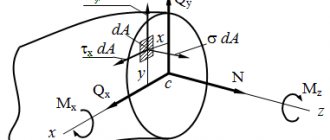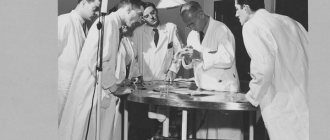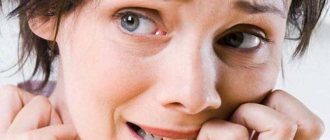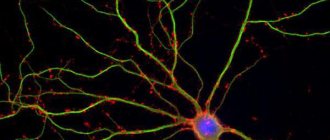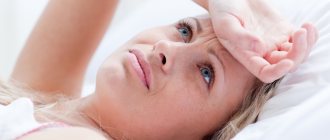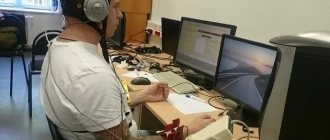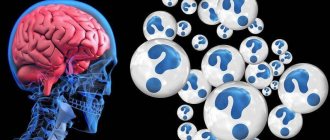| It is proposed to rename this page to Psychological Self-Regulation. Explanation of reasons and discussion - on the Wikipedia page: Towards renaming / August 15, 2017 . Perhaps its current name does not correspond to the norms of the modern Russian language and/or the rules for naming Wikipedia articles. Do not remove the flag for renaming until the end of the discussion. Rename to the suggested name, remove this template. |
Methods of psychological self-regulation
are used to independently control a person’s mental state.
Definition of self-regulation
In a broad sense, mental self-regulation is considered as one of the levels of regulation of the activity of living systems, which is characterized by the use of mental means of reflecting and modeling reality [1] [2].
Thus, mental self-regulation includes control of the behavior or activity of the subject and self-regulation of his current state [3].
There are also narrower interpretations of this phenomenon:
- “Mental self-regulation is the influence of a person on himself with the help of words and corresponding mental images” (A. V. Alekseev) [4].
- “By mental self-regulation we understand mental self-influence for the purposeful regulation of the comprehensive activities of the body, its processes, reactions and states” (L. P. Grimak, V. M. Zvonikov, A. I. Skrypnikov)[5].
According to V.I. Morosanova, self-regulation is understood as “integrative mental phenomena, processes and states” that ensure “self-organization of various types of mental activity” of a person, “integrity of individuality and the formation of human existence”[6].
Common to all definitions is the identification of the human condition as an object of influence and the focus on the use of internal means of regulation, primarily methods of psychological self-influence [3].
Self-regulation – its types and functions, effective methods
Self-regulation is an important part of the human psyche, and it is useful for every person to master it. It's about managing your mental and emotional state, and this is undoubtedly a very useful quality. By influencing oneself with mental images, controlling breathing, or using other techniques, a person can “come to his senses” quite quickly. So how do you master self-regulation?
What is self-regulation
Let us take a closer look at the concept of “self-regulation” in psychology and pedagogy.
In psychology
Self-regulation means assessing the situation and adjusting one’s own activity directly by the individual. As a result, the results of the action are adjusted. There is voluntary and involuntary self-regulation.
Voluntary form is characterized by conscious control of behavior in order to achieve the desired. With the help of conscious self-regulation, a person develops individuality. Involuntary is more aimed at survival and self-preservation - subconscious defense mechanisms are triggered.
The norm is considered to be a situation where self-regulation is formed and develops in parallel with personal maturation. If there is no personal development, a person does not learn to bear responsibility, then the situation worsens. The development of self-regulation is impossible without personal growth.
In adulthood, self-regulation helps subordinate emotions to intellect, but in old age the balance shifts again towards emotions.
Aspects influencing self-regulation
:
- external environmental conditions;
- personality traits;
- features of the relationship between the individual and the environment;
- goals of activity.
Simply put, self-regulation is socially acceptable methods of dealing with feelings and emotions, as well as accepting norms of behavior, respect for others, and adequate reactions.
In pedagogy
Teachers often have to be in stressful situations related to children, their parents, presentation of new material, and so on.
It is especially important for a teacher to master relaxation and mental self-regulation methods.
One of them can be called autogenic training - work with self-hypnosis and self-tuning of the psyche, based on the use of the relaxation process. It becomes easier to manage emotions and restore performance.
How to master auto-training
?
- learn self-hypnosis
: focus attention on a separate object (your entire body or its individual components); - visualize
the contents of self-hypnosis formulas as clearly as possible (“my hands are relaxed, I am calm”, etc.); - periodically achieve complete relaxation of your arms, legs, and torso
. Relaxation of skeletal muscles and a low level of wakefulness in the brain have a direct connection with calming the nervous system and reducing emotional tension.
Teachers are advised to pay special attention to self-regulation and influence themselves with effective language. There are many auto-training methods that help you develop the necessary skills.
Some educational institutions include psychological relief rooms, where the teacher has the opportunity to relieve tension caused by a certain irritant.
Popular methods of pedagogical self-regulation: bibliotherapy, music therapy, occupational therapy, cultivating optimism, and so on.
Theories of mental self-regulation
Let's consider popular theories of self-regulation in psychology.
System activity theory
The author of the theory is L. G. Dikaya. The concept assumes that psychological self-regulation is considered as a system and as an activity related to the individual’s professional environment and adaptation.
As a system, self-regulation can be considered in the context of the individual’s transition from unconsciousness to conscious and automatic forms.
The author has identified several levels
:
- Involuntary level
. The basis of regulation is the processes of excitation and inhibition, as well as nonspecific activity in the psyche. These reactions are uncontrollable and their duration is short. - Arbitrary level
. The need for regulation occurs in difficult life situations, emotions are involved. The reaction becomes in semi-conscious ways: increased speech and motor activity, holding your breath, muscle tension. Usually a person tries to automatically awaken himself and does not take many changes into account. - Conscious regulation
. A person becomes aware of fatigue, discomfort, tension. He can also analyze the level of severity of his condition. He decides to change the situation, and here such aspects as self-control, will, psychophysical exercises, and auto-training come into play. - Purposeful conscious level
. Clearly realizing that this can no longer continue, and the time has come to choose between psychological self-regulation, the individual, wanting to eliminate the discomfort, begins to re-prioritize and evaluate his own needs and motives. As a result, a decision is made to temporarily abandon activities and take care of one’s condition. If this opportunity is not provided, then a decision is made to continue activity in discomfort or to balance activity and self-regulation. Next comes a series of such aspects: self-persuasion, introspection, self-hypnosis, self-programming. Changes occur not only at the cognitive level, but also at the personal level.
System-functional theory
The author of the theory was A. O. Prokhorov, who considered psychological self-regulation as a transition from one mental state to another, associated with ideas about the desired mood. A conscious image helps to activate self-control and corresponding motives.
Having resorted to conscious methods to achieve what he wants, a person usually uses different methods and goes through more than one intermediate state. Subsequently, a functional structure of personality self-regulation is formed - a conscious reaction to conflict situations.
A. O. Prokhorov noted that self-regulation is a transition from one state to another, which is achieved through the connection of mental properties and internal switching of work.
The more conscious the consciousness, the more successful the regulation. Also important is the clarity of formation of the desired image and the realism of perceptions and sensations. The current position is analyzed using bodily sensations, breathing, perception of time and space.
Kinds
Modern practical psychology successfully uses different types of mental self-regulation to normalize the internal state of the individual.
Popular types include
:
- autogenic training, based on the use of special self-hypnosis formulas that allow you to influence body processes;
- self-education through certain exercises;
- biofeedback;
- meditation;
- visualization.
The conscious use of certain types of self-regulation begins at approximately three years of age.
- At 3-4 years of age,
involuntary motor and speech methods of self-regulation are predominant - for every 7-8 involuntary ones there is so far only one voluntary one. - Children 4-5 years old
learn emotional control through play. Involuntary methods still predominate: four to one. - By the age of 5-6 years
, the proportions are equalized one to one, and now children actively use imagination, memory, thinking and speech. - From the age of 6-7 years
you can already talk about self-correction and self-control. The proportions have changed dramatically: for every 3-4 voluntary methods of self-regulation, there is only one involuntary one. - From the age of 8
and throughout the entire period of growing up, an individual improves his methods, adopting them from those around him. - At the age of 20-40 years
, the type of self-regulation chosen has a direct dependence on human activity. Conscious volitional methods are mainly used. - A person of 40-60 years old
retains manipulations with attention, but they are gradually replaced by passive rest and bibliotherapy. - After 60 years
, passive relaxation, communication, reflection and comprehension are predominant.
Functions
It is important to understand the basic functions of self-regulation in psychology in order to understand its value. It changes mental activity, which allows the individual to achieve balance and harmony.
In turn, this provides us with such significant advantages
:
- Containing the first negative impulses in a conflict situation
. A person who masters self-regulation methods is able to nip conflict in the bud. - Rational analysis of the situation at a time of crisis or stress
. A very important quality that improves the life of any person and those around him. - Accumulation of strength
. However, it is important not only to accumulate strength, but also to restore it, and self-regulation does an excellent job of this. - Confronting adversity
. The subsequent quality of our life and harmony in relationships with others depends on how we confront problems.
Popular methods of self-regulation
Let's look at common methods of self-regulation.
Mechanism of natural self-regulation
One of the most accessible methods of self-regulation are natural regulation techniques.
There are quite a lot of them, we will list the simplest and most common ones.
:
- classical music;
- walk in nature;
- good sleep;
- humor, laughter, smiles;
- breathing fresh air;
- thinking about positive things;
- relaxed muscles;
- contemplation of a beautiful landscape;
- contemplating photos with a loved one, pleasant memorabilia;
- sunbathing;
- communication with a pleasant person.
Watch the video
Source: https://PsyLogik.ru/90-samoreguljacija.html
Methods
There are many PSR methods, which are divided into 4 main classes:
- neuromuscular relaxation,
- autogenic training,
- ideomotor training,
- sensory reproduction of images[3].
The objectives of using these methods are:
- relieving the manifestations of stressful conditions,
- reducing the degree of emotional intensity of activity,
- preventing their undesirable consequences,
- strengthening resource mobilization[7].
General characteristics of methods
The main features of all methods are:
- Identification of the human condition as an object of influence. This takes into account the effects on the main levels of manifestation of his functional state: physiological, psychological and behavioral.
- Focus on the formation of adequate internal means that allow a person to carry out special activities to change his condition.
- Dominance of the subject’s active attitude towards changing (regulating) his state.
- Training in RPS skills should be organized in the form of successive stages of mastering the relevant internal skills, which constitutes the main content of the training.
Neuromuscular relaxation
See also: Progressive muscle relaxation
In foreign psychology, this technique is used under the name “progressive relaxation”, so it also has another name - progressive relaxation[3]. The creation of this class of methods is associated with the research of E. Jacobson, who in the 1930s established a relationship between increased skeletal muscle tone and a negative emotional state.
The method consists of performing a set of exercises consisting of alternating maximum tension and relaxation of muscle groups. Thanks to exercises, tension is relieved from individual parts of the body or from the entire body, which causes a decrease in emotional stress. Subjectively, the process of physical relaxation is represented by sensations of warmth and pleasant heaviness, a feeling of relaxation, which causes psychological relaxation. It is important that during exercises there is a fixation on these sensations of warmth, as this prevents the appearance of a feeling of lasting heaviness in the post-relaxation period.
The technology learning process consists of three stages [3]:
- The first stage develops the skills of voluntary relaxation of individual muscle groups at rest.
- In the second, skills are combined into complexes that ensure relaxation of the entire body or individual parts of it (first at rest, later when performing certain types of activities, and relaxation of muscles not involved in the activity occurs).
- The third is learning the “relaxation skill,” which allows you to relax in any tense situation.
One session of exercises at the initial stage of teaching the technique can last from 40 to 18-20 minutes, depending on the number of times one exercise is performed. During the session, the muscles of the body parts are worked sequentially in a certain order: limbs, torso, shoulders, neck, head, face. After completing the exercises, you exit the state of relaxation.
Mastering the technique of neuromuscular relaxation is the basis for mastering other more complex techniques. This method is effective as a basic means of creating states of autogenic immersion. Another advantage is that most subjects can achieve a state of relaxation already in the first session.
Ideomotor training
This technique also consists of sequentially tensing and relaxing the muscles of the body, but the exercises are not performed in reality, but mentally. The method is based on experimentally established facts of the similarity of the state of muscle tissue during real and imaginary movement. These facts are indicated in the studies of the physiologist Academician I.P. Pavlov; in addition, they are confirmed by the “Carpenter effect”: the potential of electrical activity of a muscle when mentally reproducing a movement is the same as the potential of the same muscle when performing a real movement. In addition, it has been experimentally proven that during an imaginary movement, internal feedback arises, carrying information about the results of the action, like feedback signaling when performing a real movement [3].
Ideomotor training can be used as an independent method of reducing muscle tone and as a method of mental self-programming in a state of relaxation.
Sensory reproduction of images
The method consists of relaxation by imagining images of objects and complete situations associated with relaxation. Sensory reproduction of images can be used as an independent technique[3].
In one version of the sessions, the subject sits in a comfortable position and imagines himself in a relaxing situation (for example, a walk in the forest). In this case, attention is focused on proper breathing and pleasant sensations (warmth, heaviness) that arise in various parts of the body under the influence of an imaginary situation.
Often the technique of sensory image reproduction is used in a group with visualization and meditation techniques. The visualization technique is more similar in its principles and mechanisms to ideomotor training. Meditation, on the contrary, is more similar to the method of sensory reproduction of images: it is also characterized by relaxation by concentrating thoughts on the image of an object or phenomenon, or on the image of oneself and one’s inner world, and it also focuses on correct breathing. However, during meditation, a person experiences a deeper autogenic immersion, and in this state, his level of suggestibility increases sharply.
Autogenic training
Main article: Autogenic training
The method is based on teaching the possibilities of self-hypnosis, or autosuggestion. Self-hypnosis in this case is carried out through verbal formulations - self-orders. During training, connections are formed between self-orders (for example, “I breathe evenly and calmly”) and psychophysiological processes in the body. A subject who has completed a certain course of training can, using certain self-hypnosis formulas, evoke the necessary sensations in the body [3].
With the help of formulas, after leaving autogenic immersion, you can induce both a state of relaxation and a state of activation, depending on the goal. Usually a fixed set of formulas is used, but it can be individually modified. Often the skills acquired through neuromuscular relaxation training provide a good basis for autogenic training. The method can be used as auto-training and as hetero-training: in the first case, the formulas are “instructions to oneself”, in the second - the psychologist takes part in the influence.
There are different options for the autogenic training method:
- The classic version of autogenic training (method of I. G. Schultz). The system is represented by six standard AT exercises aimed at muscles, blood vessels, heart, breathing, abdominal organs, and head. During the exercise, attention is fixed on a certain area of the body or organ, a formula is repeated (for example, “My right hand is heavy”) and the desired sensations are imagined. After several months of training, the patient can use a certain phrase to evoke the desired sensation.
- Modification of the classic version of autogenic training in the form of self-interaction. This technique was given by A.I. Nekrasov. In this version of the training, 6 directions of influence are changed: heaviness, warmth, breathing, heart, stomach, forehead. For each direction, several formulas are used, each of which is repeated several times.
- Modification of the classic version by L. D. Gissen. This option involves two parts of exercises: calming and mobilization. The calming part contains 5 groups of 10 formulas each, the first group is introductory. The mobilization part contains 2 groups: activation formulas and toning formulas.
- Autoophthalmic training is a technique developed by L. P. Grimak and A. A. Israelyan. It is aimed at eliminating visual defects that are at an early stage of development and allows you to delay the development of chronic visual fatigue. The technique involves performing special exercises that form visual images, working with which a person improves visual functions. According to L.P. Grimak, during a session a person first immerses himself in a state of peace, then mentally accumulates heat around the eyes, then he imagines a point, which he forces to move away and closer, to move along a different trajectory. Thus, a person mentally performs gymnastics for the eyes. At the end of the session, he emerges from the state of autogenic immersion. When performing exercises, attention is paid to breathing and the sensations caused[5].
- Autogenic training technique in the form of heterotraining. This type of training involves some participation of the psychologist in the patient’s self-regulation. This technique is usually used during a short break from work. It consists of two main parts: the stage of immersion and the stage of emerging from deep degrees of autogenic immersion.
- There are a large number of other modifications of autogenic training (for example, the methods of Svyadoshcha, Kleinsorge-Klumbies (1966), etc.).
Types of self-regulation in psychology and philosophy: what allows use, examples
Self-regulation is the ability of various systems to maintain a stable balance at the proper level, regardless of external influences. The property affects many aspects, therefore it is carefully studied by philosophers, biologists, sociologists, and psychologists.
How to manage your emotions
What it is
Stability depends on the ability of living multi-level systems to organize. There are several opinions about what self-regulation is, and in some ways they are similar. Differences in judgments are associated with the position from which the analyst looks at this topic. Philosophers and psychologists are most interested in the question.
Definition in philosophy
Science studies the processes of cognition and thinking, values and moral categories from the perspective of the development of society and the world as a whole. If we consider the property of control, then in philosophy self-regulation is the ability of a person to completely control himself through the primacy of consciousness.
Here it is important to choose the right position regarding your inner world:
- if the desire to manipulate them is added to the awareness of thoughts and feelings, this can lead to intrapersonal conflict;
- accepting the inner world as an integral part of oneself, respecting it is the right path to a productive life;
- when awareness of the inner world becomes the basis for changing one's own behavior, this can provoke a war with oneself.
For your information. Awareness will always prevent constructive changes in behavior. The effectiveness of self-regulation lies in the fact that a person can control his behavior, regardless of his own consciousness.
Psychologists' opinion
Dynamic, energetic, content-semantic aspects make it possible to realize and model reality. Therefore, in psychology, self-regulation is considered as one of the levels of correction of system activity.
Experts present psychological self-realization as an informational process based on mental forms of reflection of reality. In this closed loop, implementation occurs through various means: representations, images, concepts, etc. This is influenced by external factors and activities.
Taken as a basis, a goal can produce different results even with similar behavior patterns. It all depends on personal qualities, the nature of nervous activity, habits, lifestyle, and degree of organization.
Basic theories of self-regulation
Self-control - what is it in psychology, definition
In scientific works and coursework there are various theories about self-regulation of behavior. They all agree that managing the psyche and emotions is interconnected with the type of activity. Due to certain circumstances, intellect or emotions may be dominant.
Mechanisms of self-regulation
Subconscious - what is it, definition
Thanks to changes in psychological activity, the subject is able to achieve balance and harmony of states. This provides the following capabilities:
- the ability to resist negative aspects of life;
- ability to restrain yourself in conflict situations;
- the ability to think rationally during crises and stress;
- restoration of strength.
On a note. For self-regulation to become conscious, you need qualities such as responsibility, independence, flexibility, perseverance, and reliability.
Components and levels
To understand how the self-regulation mechanism works, you need to consider 2 main elements of this property:
- Self-control, which begins to develop from the age of 3. It helps to give up something desired and pleasant for an important purpose.
- In the normal development of a child, consent is formed at 7 years of age. A person is able to agree with what he cannot do and what he can do.
Self-control
To learn to build new impulses and motives through mental control, a person must have willpower.
Levels of self-regulation
Name Brief definition
| Operational and technical | Conscious organization of activities using available means |
| Motivational | Directing your actions through conscious regulation of needs and emotions |
The control mechanism is an individual choice for everyone. Self-regulation is activated when the need arises to change oneself, and not circumstances.
The function of self-regulation in humans
Affirmation - what is it, definition
Managing emotions and behavior is impossible without self-esteem, ego concept, life priorities and level of aspirations. Character, temperament, mental characteristics and gender are important here.
Self-regulation in men and women
Even those who have not studied physiology know that women are emotionally more fragile creatures. They perceive situations and react to them differently.
Features of self-regulation
For men For women
| • Less susceptible to fears, worries, irritation, fatigue; • But more often they fall into depression, apathy and loneliness; • Thanks to the biological basis of self-regulation, men have more methods for its manifestation | • The psycho-emotional aspect is manifested to a greater extent than in men; • It is loneliness that can plunge you into a depressive state; • Management methods are social in nature |
The difference can also be seen in the direction of self-regulation. For men it is internal, for women it is external.
Features of gender response
The main factor influencing management features is the psychophysiological difference between the sexes. The process is also determined by the following aspects:
- gender cultural stereotypes;
- differences in the upbringing of boys and girls;
- specifics of activity;
- differentiation of social roles.
Levels of personality development, mental state, and age characteristics can also influence.
The emergence of self-regulation and its development
The child begins to consciously use self-regulation methods when he comes to understand his own “I”. This is determined during the period of 3 years of age. From this moment on, there is a continuous development of self-regulation according to certain dynamics. It is actively used in pedagogy for raising children.
Stages of development of self-regulation
AgeFeatures
| 3-4 years | Manifests itself in speech and motor ways of an involuntary nature, but voluntary ones are also possible in a ratio of 1:7 |
| 4-5 years | Games teach emotional control. Here you can already observe arbitrary methods (1 to 4 involuntary) |
| 5-6 years | Both types of self-regulation are in equal proportion. Thinking, imagination, use of memory and speech are actively used |
| 6-7 years | A normally developing child shows signs of self-correction and self-control. The species ratio changes again in favor of arbitrary methods (3:1) |
| further up to 20 years | Children continue to learn management methods from adults and improve them to suit their personal characteristics. |
| 20-40 years | Self-regulation is influenced by human activity. At this stage, volitional methods (switching attention, self-order) using communication are more often manifested |
| 40-60 years | Gradually, manipulations with attention are replaced by passive rest, bibliotherapy and reflection. |
| over 60 years old | The way out of discomfort is through passive discharge, communication, and understanding the situation. |
Type of children's self-regulation
The development of management is influenced by social aspects, age-appropriate activities, and even the environment. The main driver of development can be called motivation. The higher it is, the more perfect the regulation system.
Examples of self-regulation from life
Mastering control methods, a person independently selects for himself the most acceptable “recipe for sedation.” To normalize the condition, he can use a whole range of actions:
- take a walk in the evening park;
- go fishing;
- listen to music alone, etc.
Some will benefit from breathing therapy, while others will benefit from good sleep. Examples of women’s self-regulation include a run to the shops or a cup of coffee and cake in the company of a friend.
Example of self-regulation
Young people relieve stress in the gym or at the disco. Those who are older wrap themselves in their favorite blanket, pick up a book and distract themselves from the uncomfortable situation. Elderly people find peace in communicating with their grandchildren.
Source: https://srazu.pro/teoriya/samoregulyaciya-opredelenie.html
Notes
- Meshcheryakov B. G., Zinchenko V. P.
Mental self-regulation // Big psychological dictionary. - St. Petersburg, 2003. - P. 433. - ISBN 5-93878-086-1. - Leonova A. B., Kuznetsova A. S.
Psychological technologies for managing the human condition.
- M: Smysl, 2009. - 311 p. — ISBN 978-5-89357-241-4; Konopkin O. A.
Psychological mechanisms of activity regulation.
M.: Nauka, 1980; Morosanova V.I.
Individual style of self-regulation. - M.: Nauka, 2001. - ↑ 1 2 3 4 5 6 7 8 Leonova A. B., Kuznetsova A. S.
Psychological technologies for managing the human condition. - M: Smysl, 2009. - 311 p. — ISBN 978-5-89357-241-4 - Alekseev A.V.
On the adequacy of self-hypnosis formulas // Theoretical and applied studies of mental self-regulation / Ed. N. M. Peysakhova. Kazan: KSU Publishing House, 1976. - ↑ 1 2 Grimak L.P., Zvonikov V.M., Skrypnikov A.I.
Mental self-regulation in the activities of a human operator // Questions of cybernetics. Mental states and performance effectiveness / Ed. Yu. M. Zabrodina. M.: Publishing House of the USSR Academy of Sciences, Scientific Council on the complex problem “Cybernetics”, 1983. - Morosanova V.I.
Self-regulation and human individuality / Institute of Psychology RAS; Psychological Institute RAO. - M.: Nauka, 2010. - P. 8. - Leonova A. B., Kuznetsova A. S.
Psychological technologies for managing the human condition.
- M: Smysl, 2009. - 311 p. - ISBN 978-5-89357-241-4, Dikaya L.G., Semikin V.V.
The regulatory role of the image of the functional state in extreme conditions of activity // Psychological Journal. 1991. T. 12. No. 1. P. 55-65.
Self-regulation in psychology: methods and techniques – Self-development
A negative emotional state has a destructive effect on an individual's health. Because of this, people are looking for ways to control their behavior and mental state. Self-regulation in psychology is an effective technique for emotional self-defense. This is a set of actions aimed at controlling the psyche in critical, negative situations.
Concept
Psychological self-regulation is an objective assessment of the situation, directed activity that allows you to control your own activity and correct the results of your actions.
There are two types of psychological self-defense:
- Involuntary - natural defense mechanisms that come from the subconscious. Focused on survival.
- Voluntary - conscious control of actions to achieve a set goal.
Self-regulation itself is formed throughout life, but self-awareness stops developing when a person stops learning responsibility and abandons self-development. Because of this, self-regulation suffers.
In adulthood, control over emotions is exercised by the intellect and is at its highest point. As we age, this balance shifts toward emotions. Because of this, psychologists compare old people with children.
Self-regulation depends on several factors:
- set goals;
- personality traits;
- environmental conditions;
- relationships between the subject and the surrounding world.
It is impossible to establish productive activities without a set goal; for this you need to additionally learn to control emotions.
History of the discovery of the ability
The first scientist who made a great contribution to the discovery and further development of this skill was I.P. Pavlov. He learned to artificially influence the blood pressure of animals and change it using several methods:
- small cuts;
- introduction of various substances into the blood;
- nerve irritation.
He proved that after a change in blood pressure, it is enough to wait a little for it to recover. Thanks to this, the principle of self-regulation was developed. With the help of further research, the scientist found that this principle applies to all functions of the body.
Functions and mechanisms
The function of the method is to change mental activity, allowing the subject to achieve a state of balance and harmony. Thanks to this, a person can perform several actions:
- cope with any adversity that arises throughout life;
- control your condition in various conflict situations;
- restore your own strength;
- think rationally under stress.
Theories and levels
There are several current theories of self-regulation, each of which has certain features.
System-activity regulation
Its author is L. G. Dikaya. It is simultaneously considered as a system and an activity. The author identified 4 levels of self-regulation:
- Involuntary - regulations that are based on activity that manifests itself during inhibition and excitement of the psyche. The individual cannot control involuntary reactions, but their duration is short-lived.
- Conscious - due to constant discomfort, a person faces the choice of developing self-regulation or performing some action to get out of the current situation. He sets priorities, changes the value of needs, evaluates motives. At the same time, self-programming, self-persuasion, self-hypnosis, introspection, and self-order begin to work. Personal and cognitive changes occur.
- Conscious regulation. The person feels discomfort and can realize the level of negative state. After realizing the situation, the subject makes a choice between ways to change his own state. This can be a manifestation of willpower, auto-training, psychophysical exercises, self-control.
- Arbitrary level. Self-regulation manifests itself only under severe stress and extreme fatigue. This may include holding your breath, muscle tension, convulsions, speech activity, emotions, gestures that cannot be controlled.
Features of ability depending on gender and age
Scientists have proven that women are more susceptible to the negative influence of fears, fatigue, anxiety, and irritation. Men experience stress, apathy, and loneliness within themselves, without sharing with others.
There are differences between the sexes in self-regulation. This is due to several factors:
- specifics of work;
- gender, cultural stereotypes;
- differences in education and upbringing of boys and girls;
- historical factors due to which the differentiation of social roles has developed.
Certain features of monitoring one’s own psychological state relate to age. The younger a person is, the less control he has over his emotions. This is due to a lack of life experience, information accumulated over the years of life, and hormones. In adulthood, people reach their maximum level of self-regulation. With the aging process, emotions take their toll.
Techniques for controlling mental state first appear at 3 years of age. From this moment on, the child becomes aware of his Self.
Age-related manifestations of regulation:
- From 3 to 4 years old, motor and speech control techniques predominate in children, which manifest themselves involuntarily.
- From 4 to 5 years old - children learn emotional control through games. At this age, involuntary methods predominate.
- From 5 to 6 years old, the process of equalizing the proportions between involuntary and voluntary methods occurs. Thinking, imagination, speech, memory are actively developing.
- From 6 to 7 years old, children learn self-correction and self-control. Because of this, the proportions change. There is 1 involuntary method of regulation, 3 voluntary ones.
- Until the age of 20, adolescents develop acquired methods by actively learning from adults.
- From 20 to 40 years old, methods of self-regulation are chosen depending on what activity the person is engaged in.
- 40-60 years - passive rest, reading books, reflections are replacing the chosen methods of regulation.
- 60 years - communication, comprehension of the past, and passive relaxation begin to predominate.
The development of self-control techniques is greatly influenced by the social status and activity of the individual.
Methods and techniques
People use different methods of self-regulation:
- meditation;
- relaxation;
- self-hypnosis;
- desensitization;
- autogenic training;
- reactive relaxation.
Autogenic training
They were first proposed by a doctor from Germany, Schultz. Their principle is self-hypnosis. The techniques can be mastered through systematic exercises. The techniques are available to anyone. Thanks to training, you can cope with stress, strengthen strong-willed qualities, and normalize the emotional sphere.
Popular methods:
- To fill the capillaries with blood, you can think about heat, to relax the muscles - imagine lifting weights.
- Training to master the correct breathing technique. To do this, a person experiences a feeling of heaviness and warmth. They suggest to him that the heart rhythm is even. Once the subject is prepared, he should begin to repeat the phrase “I am calm.”
With the help of self-hypnosis, you can control your emotions and change your own state.
Literature
- Alekseev A.V.
On the adequacy of self-hypnosis formulas // Theoretical and applied studies of mental self-regulation / Ed. N. M. Peysakhova. Kazan: KSU Publishing House, 1976. - Grimak L.P., Zvonikov V.M., Skrypnikov A.I.
Mental self-regulation in the activities of a human operator // Questions of cybernetics. Mental states and performance effectiveness / Ed. Yu. M. Zabrodina. M.: Publishing House of the USSR Academy of Sciences, Scientific Council on the complex problem “Cybernetics”, 1983. - Dikaya L.G., Semikin V.V.
The regulatory role of the image of the functional state in extreme conditions of activity // Psychological Journal. 1991. T. 12. No. 1. P. 55-65. - Konopkin O. A.
Psychological mechanisms of activity regulation. M.: Nauka, 1980. - Leonova A. B., Kuznetsova A. S.
Psychological technologies for managing the human condition. - M: Smysl, 2009. - 311 p. — ISBN 978-5-89357-241-4. - Morosanova V.I.
Individual style of self-regulation. M.: Nauka, 2001. - Morosanova V.I.
Self-regulation and human individuality / Institute of Psychology RAS; Psychological Institute RAO. - M.: Nauka, 2010. - 519 p. — ISBN 978-5-02-037102-6. - Oboznov A. A.
Mental regulation of operator activity (in special conditions of the working environment). M.: Publishing House IP RAS, 2003.
To improve this article it is desirable:
|

